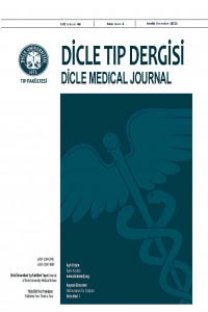Alopesi areata'da IL-6 Promotör Polimorfizmi
IL-6 Promoter Polymorphism in Alopecia Areata
___
- 1. Seok H, Suh DW, Jo B, Lee HB, Jang HM, Park HK. Association between TLR1 polymorphisms and alopecia areata. Autoimmunity 2014;1-6.
- 2. Kim SK, Park HJ, Chung JH, et al. Association Between Interleukin 18 Polymorphisms and Alopecia Areata in Koreans. Journal Of Interferon & Cytokıne Research 2014;34.
- 3. Jabbari A, Petukhova L, Cabral RM, et al. Genetic basis of alopecia areata: A roadmap for translational research. Dermatol Clin. 2013;31:109-17.
- 4. Cork MJ, Crane AM, Duff GW. Genetic control of cytokines. Cytokine gene polymorphisms in alopecia areata. Dermatol Clin. 1996;14:671-8.
- 5. de Andrade M, Jackow CM, Dahm N, et al. Alopecia areata in families: association with the HLA locus. J Investig Dermatol Symp Proc. 1999;4:220-3.
- 6. Rodriguez TA, Fernandes KE, Dresser KL, Duvic M. National Alopecia Areata Registry. Concordance rate of alopecia areata in identical twins supports both genetic and environmental factors. J Am Acad Dermatol 2010;62:525-7.
- 7. Sundberg JP, Silva KA, Li R, et al. Adult-Onset Alopecia Areata Is a Complex Polygenic Trait in the C3H/HeJ Mouse Model. J Invest Dermatol 2004;123:294 -7.
- 8. Blaumeiser B, Goot Ineke van der, Fimmers R, et al. Familial aggregation of alopecia areata. J Am Acad Dermatol 2006;54:627-32.
- 9. Wang E, McElwee KJ. Etiopathogenesis of alopecia areata: Why do our patients get it? Dermatologic Therapy 2011;24:337-47.
- 10. Ito T, Tokura Y. The role of cytokines and chemokines in the T-cell-mediated autoimmune process in alopecia areata. Experimental Dermatology 2014;23:787-91.
- 11. Kalkan G, Karakus N, Baş Y, et al. The association between Interleukin (IL)-4 gene intron 3 VNTR polymorphism and alopecia areata (AA) in Turkish population. Gene 2013;527:565-9.
- 12. Uçmak D, Balcı G, Harman M. Evaluation of interleukin-2 and tumor necrosis factor-? levels in patients with lichen planus. Dicle Med J. 2012;39:6-8.
- 13. Sımpson RJ, Hammacher A, Smıth DK, Matthews JM, Ward LD. Interleukin-6: Structure-function relationships. Protein Science 1997;6929-55.
- 14. Hirano T. Interleukin 6 and its receptor: ten years later. Int Rev Immunol. 1998;16:249-84.
- 15. Wang HY, Zhang JJ, Zheng XY, et al. Association between IL- 6 Gene (- 174 & -572 G/C) Polymorphisms and Endometrial Adenocarcinoma Risk. Pathol. Oncol. Res. DOI 10.1007/s12253- 016-0073-6.
- 16. Belluco C, Olivieri F, Bonafe M, et al. -174G/C polymorphism of interleukin 6 gene promoter affects interleukin 6 serum level in patients with colorectal cancer. Clin Cancer Res. 2003;9:2173-6.
- 17. Bilgic O, Sivrikaya A, Unlu A, Altinyazar HC. Serum cytokine and chemokine profiles in patients with alopecia areata. J Dermatolog Treat. 2015;Oct 7:1-4.
- 18. Atwa MA, Youssef N, Bayoumy NM. T-helper 17 cytokines (interleukins 17, 21, 22, and 6, and tumor necrosis factor-a) in patients with alopecia areata: association with clinical type and severity. International Journal of Dermatology 2016;55:666- 72.
- 19. Cussigh A, Falleti E, Fabris C, et al. Interleukin 6 promoter polymorphisms influence the outcome of chronic hepatitis C. Immunogenetics 2011;63:33-41.
- 20. Pekiner FN, Aytugar E, Demirel GY, Borahan MO. Interleukin-2, interleukin-6 and T regulatory cells in peripheral blood of patients with Behc¸et's disease and recurrent aphthous ulcerations. J Oral Pathol Med. 2012;41:73-79.
- 21. Demirturk F, Ates O, Gunal O, et al. IL-6 gene promoter polymorphisms: genetic susceptibility to recurrent pregnancy loss. Bratisl Lek Listy 2014;115:479-82.
- 22. Al-Banna N, Raghupathy R, Albert MJ. Correlation of Proinflammatory and Anti-Inflammatory Cytokine Levels with Histopathological Changes in an Adult Mouse Lung Model of Campylobacter jejuni Infection. Clınıcal And Vaccıne Immunology, Dec. 2008;1780-7.
- 23. Bodemer C, Peuchmaur M, Fraitaig S, et al. Role of Cytotoxic T Cells in Chronic Alopecia Areata. J Invest Dermatol 2000;114:112-6.
- 24. Gregoriou S, Papafragkaki D, Kontochris GT, et al. Cytokines and Other Mediators in Alopecia Areata. Hindawi Publishing Corporation Mediators of Inflammation, 2010;5.
- 25. Brull DJ, Montgomery HE, Sanders J, et al. Interleukin-6 gene -174g > c and -572g > c promoter polymorphisms are strong predictors of plasma interleukin-6 levels after coronary artery bypass surgery. Arterioscler Thromb Vasc Biol. 2001;21:1458-63.
- ISSN: 1300-2945
- Yayın Aralığı: 4
- Başlangıç: 1963
- Yayıncı: Cahfer GÜLOĞLU
Alopesi areata'da IL-6 Promotör Polimorfizmi
Diyabetik Nefropati Progresyonunda Nt-Pro BNP ve Volüm Yükü Arasındaki İlişki
Yaşar YILDIRIM, ZÜLFÜKAR YILMAZ, Müslüm GÜNEŞ, Ali Veysel KARA, Ali Kemal KADİROĞLU, MEHMET EMİN YILMAZ
Çocuklarda apandisit için risk faktörleri analizi: Çok merkezli epidemiyolojik çalışma
SERKAN ARSLAN, BAHATTİN AYDOĞDU, Mehmet Şerif ARSLAN, HİKMET ZEYTUN, MEHMET HANİFİ OKUR, Erol BASUGUY, Ali Erdal KARAKAYA, İbrahim UYGUN, Selçuk OTÇU
Giresun İli'ndeki Sularda Parazitlerin Varlığı
Ülkü KARAMAN, Zeynep KOLÖREN, Elif DEMİREL, Emine AYAZ, Onuralp SEFEROĞLU
Bengü Çevirgen CEMİL, Hatice ATAŞ
Diyarbakır'da Bir Bomba Patlaması: Klinik Bulgular ve Acil Servis Yönetimi
MUSTAFA İÇER, Yılmaz ZENGİN, HASAN MANSUR DURGUN, RECEP DURSUN, Baran ARI, Mustafa EKİNCİ, Mehmet Üstündağ ÜSTÜNDAĞ, MURAT ORAK, Cahfer GÜLOĞLU
Yaşar KANDUR, Sevinç ÖZDEN, BAHAR BÜYÜKKARAGÖZ
Atipik Hemolitik Üremik Sendromda Ekulizumab Kullanımı: Tek Merkez Deneyimi
Nilüfer GÖKNAR, Faruk ÖKTEM, Ayşegül Doğan DEMİR, AYSEL VEHAPOĞLU TÜRKMEN, Mehmet KÜÇÜKKOÇ
Yeliz Aktürk, Mehmet Murat Fırat, Mehmet Emrah Güven, Murat Beyhan
HCT116 Hücrelerinde Floropirimidinlere Karşı p67phox'un Fazla Ekspresyonu
